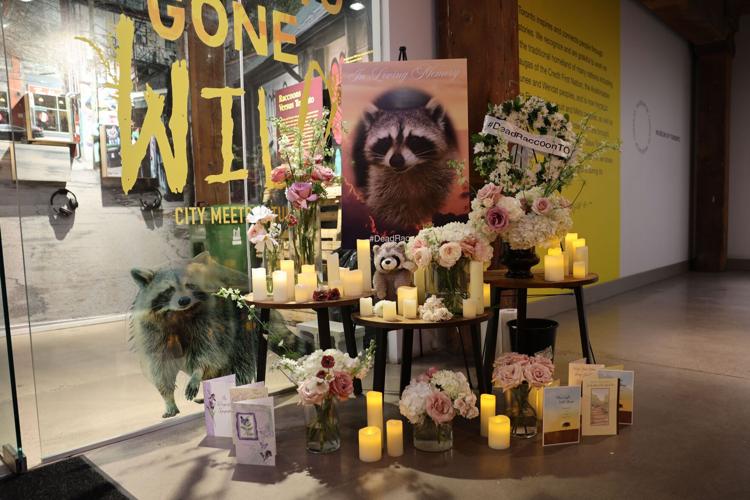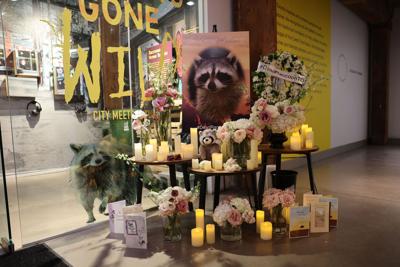The spot where he died is, on the whole, quite ordinary.
ThereŌĆÖs a dentist’s office, a community centre, a vape store, a Canadian Tire. A short street light rises from the sidewalk and a green bike lane lines the curb.
But it was at this spot nine years ago ŌĆö this ordinary corner of downtown, where Yonge and Church streets intersect ŌĆö where something extraordinary happened, after a soon-to-be╠²╬┌č╗┤½├Į icon drew his last breath.
Perhaps he’d sifted through the garbage can sitting on the sidewalk, eating something two months expired and reaping the consequences. Perhaps he’d been too brazen, stumbling into the roadway and meeting the grille of a 2008 Honda Civic. Or perhaps his was a natural death, brought on by disease or simple heart arrhythmia.
Whatever the cause, when Conrad the raccoon died, and his body╠²remained on the sidewalk for 14 hours╠²despite calls to animal services, ╬┌č╗┤½├Į’s residents did not allow him to be forgotten.
Instead, they created a memorial ŌĆö first with a single red rose and ŌĆ£get wellŌĆØ card, later with candles and a donation box.
The hashtag #DeadRaccoonTO blew up. The city’s reaction to his death╠²became an international headline, from the Washington Post to Time Magazine to the Daily Mail, and a symbol of how wildlife and humans interact in Canada’s biggest city.
A memorial was held at╠²the Museum of ╬┌č╗┤½├Į this week, nine years to the day since Conrad died, commemorating his death, complete with a eulogy and moment of silence.

The ╬┌č╗┤½├Į Gone Wild exhibit at the Museum of ╬┌č╗┤½├Į explores the history and importance of this city’s urban creatures ŌĆö including Conrad the raccoon.
R.J. Johnston/╬┌č╗┤½├Į StarConrad’s fate, of course, is not unique. More than 75,000 dead raccoons have been reported to ╬┌č╗┤½├Į Animal Services since 2014, an average of nearly 20 a day for the past decade. ThatŌĆÖs on top of the more than 76,000 reports of injured, distressed or sick raccoons over that same span.
Add it up and the city has been receiving an average of nearly 40 reports of dead, injured, distressed or sick raccoons every day for 10 years. ItŌĆÖs an astounding number ŌĆö but only a fraction of the cityŌĆÖs population, of which there is no official count but various estimates place between 100,000 and 200,000 raccoons.
And they cause problems. They pillage trash cans and green bins, despite this cityŌĆÖs best efforts to keep them out. In 2016 and 2017, ╬┌č╗┤½├Į rolled out half a million supposedly raccoon-proof green bins it╠²spent $31 million on ŌĆö only for the critters to start breaking into them months later.
They rob us of power, too. Between 2013 and 2023, raccoons caused at least 105 power outages in this city, according to ╬┌č╗┤½├Į Hydro, a number that peaked at 15 in 2020. The utility promises it tries to animal-proof its system. The raccoons get in anyway, often greeted by the shock of their lives.
There were political blunders, declarations of war, even an unsolved murder. And in the span of
Raccoons are part of ╬┌č╗┤½├ĮŌĆÖs identity ŌĆö something demonstrated by how Conrad lingers in our collective conscience. In a city that so often struggles to find what unites it, raccoons are a universal experience.
That fact is being celebrated right now at the Museum of ╬┌č╗┤½├Į, which hosted Conrad’s memorial to highlight its current exhibit, ╬┌č╗┤½├Į Gone Wild. There,╠²attendees can add their raccoon horror stories to a wall full of them.
ŌĆ£A raccoon tries to climb my shed and eat from the bird feeder,ŌĆØ one reads. ŌĆ£Also washes his hands in my pond.ŌĆØ
ŌĆ£I saw through a window a raccoon strolling along the sidewalk in broad daylight,ŌĆØ another says. ŌĆ£Everyone on the street could not help but stare.ŌĆØ
Heidi Reitmaier, the executive director of the museum, has her own tale. She once opened her garbage bin to find four raccoons staring back at her.
ŌĆ£I screamed and they just stayed put,ŌĆØ she said.
The year Conrad died on that city sidewalk, 2015, was a golden age for raccoons, according to Adam Bunch, the ╬┌č╗┤½├Į historian who eulogized Conrad on Tuesday. That same year, a raccoon . Months later, a raccoon was caught from a ╬┌č╗┤½├Į-area coffee shop.

╬┌č╗┤½├Į historian Adam Bunch eulogized Conrad the raccoon on Tuesday, the ninth anniversary of the critter’s death.
R.J. Johnston/╬┌č╗┤½├Į StarAnd in Conrad, a city came together,╠²however briefly.
ŌĆ£We could all see ourselves in that poor, little, dead raccoon,ŌĆØ Bunch said in his eulogy. ŌĆ£It gave us a chance to show a different side of ╬┌č╗┤½├Į ŌĆö a more joyous side.ŌĆØ
That hasnŌĆÖt been forgotten. Two months after ConradŌĆÖs death, he was at the Canadian National Exhibition. Just last year, a for Winter Stations at Woodbine Beach ŌĆö and brought back again for 2024.
But perhaps the only reminders ╬┌č╗┤½├Į needs of Conrad’s legacy are the raccoons that prowl its streets every night, toppling green bins and tying this city together.
With files from Andy Takagi.

































To join the conversation set a first and last name in your user profile.
Sign in or register for free to join the Conversation